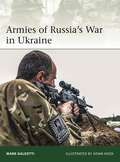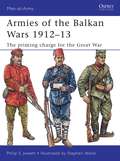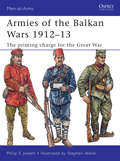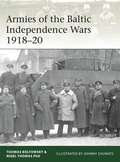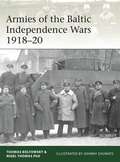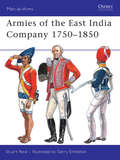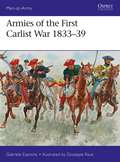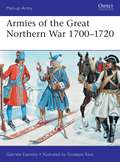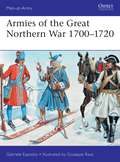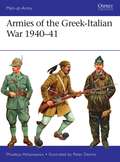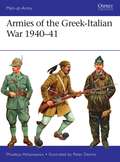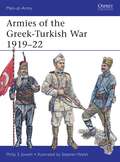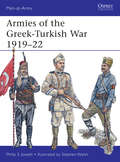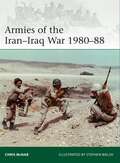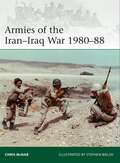- Table View
- List View
Armies of Russia's War in Ukraine (Elite)
by Mark GaleottiIn February 2014, street protests in Kiev and other Ukrainian cities led to the ousting of the Russian-backed President Yanukovych. The so-called Euromaidan Revolution saw many changes to Ukraine's constitution, but the violent reaction in the east and south of the country led to armed counter-revolution, unofficially backed by Russia.This conflict is the essential example of Russia's new policy of 'hybrid warfare', which blends propaganda, misinformation, and the deployment of 'deniable' Special Forces and regular troops alongside proxies and mercenaries to achieve its strategic ends. Using his extensive contacts in both Russia and Ukraine, and access to a mass of official and unofficial sources, Mark Galeotti presents a thorough and intriguing primer on all the forces involved in the ongoing conflict in Ukraine. Supported by specially commissioned artwork, he analyses both the progress of the war, and what it teaches us about Russia's current military capabilities.
Armies of Russia's War in Ukraine (Elite #228)
by Mark GaleottiIn February 2014, street protests in Kiev and other Ukrainian cities led to the ousting of the Russian-backed President Yanukovych. The so-called Euromaidan Revolution saw many changes to Ukraine's constitution, but the violent reaction in the east and south of the country led to armed counter-revolution, unofficially backed by Russia.This conflict is the essential example of Russia's new policy of 'hybrid warfare', which blends propaganda, misinformation, and the deployment of 'deniable' Special Forces and regular troops alongside proxies and mercenaries to achieve its strategic ends. Using his extensive contacts in both Russia and Ukraine, and access to a mass of official and unofficial sources, Mark Galeotti presents a thorough and intriguing primer on all the forces involved in the ongoing conflict in Ukraine. Supported by specially commissioned artwork, he analyses both the progress of the war, and what it teaches us about Russia's current military capabilities.
Armies of the Adowa Campaign 1896: The Italian Disaster in Ethiopia (Men-at-Arms)
by Raffaele Ruggeri Sean McLachlanIn the late 19th century, the new nation-state of Italy was eager to join her European neighbours in creating an international empire, and her eyes turned toward Africa as a source of potential colonies. Securing a foothold in Eritrea on the Red Sea coast, the Italians quickly became embroiled in a shooting war with the Ethiopians. The war proved a disaster for the Italians, who suffered three major defeats against the forces of Emperor Menelik's army, including a horrendous massacre at Adowa, the largest defeat of a colonial army prior to World War I. This book looks at the campaign with an emphasis on the colourful uniforms worn by both sides.
Armies of the Adowa Campaign 1896: The Italian Disaster in Ethiopia (Men-at-Arms #471)
by Raffaele Ruggeri Sean McLachlanIn the late 19th century, the new nation-state of Italy was eager to join her European neighbours in creating an international empire, and her eyes turned toward Africa as a source of potential colonies. Securing a foothold in Eritrea on the Red Sea coast, the Italians quickly became embroiled in a shooting war with the Ethiopians. The war proved a disaster for the Italians, who suffered three major defeats against the forces of Emperor Menelik's army, including a horrendous massacre at Adowa, the largest defeat of a colonial army prior to World War I. This book looks at the campaign with an emphasis on the colourful uniforms worn by both sides.
Armies of the Balkan Wars 1912–13: The priming charge for the Great War (Men-at-Arms)
by Stephen Walsh Philip JowettIn 1912, the Balkan states formed an alliance in an effort to break free from the crumbling Ottoman Empire. Forming an army of some 645,000 troops from Greece, Bulgaria, Serbia and Montenego, they took on a force of 400,000 Turkish soldiers. Both sides were equipped with the latest weapons technology. This book looks at the diverse and sometimes colourful uniforms worn by both sides, paying special attention to insignia, weapons and equipment. It also gives an overview of the campaigns that became a 'priming pan' of World War I.
Armies of the Balkan Wars 1912–13: The priming charge for the Great War (Men-at-Arms #466)
by Stephen Walsh Philip JowettIn 1912, the Balkan states formed an alliance in an effort to break free from the crumbling Ottoman Empire. Forming an army of some 645,000 troops from Greece, Bulgaria, Serbia and Montenego, they took on a force of 400,000 Turkish soldiers. Both sides were equipped with the latest weapons technology. This book looks at the diverse and sometimes colourful uniforms worn by both sides, paying special attention to insignia, weapons and equipment. It also gives an overview of the campaigns that became a 'priming pan' of World War I.
Armies of the Baltic Independence Wars 1918–20 (Elite)
by Nigel Thomas Toomas BoltowskyImmediately following the end of World War I, amid the collapse of the German, Austro-Hungarian and Russian Empires, bitter fighting broke out in the Baltic region as Poland, Finland, Estonia, Latvia and Lithuania struggled for their independence, and Red and White Russian armies began their civil war. There were also German forces still active in what had been the northern end of Germany's Eastern Front. This book offers a concise but detailed introduction to this whole theatre of war, focusing on the Estonian, Latvian, Lithuanian and relevant German and Russian forces, plus Finnish, Danish and Swedish contingents. For each region there is a detailed map as well as meticulous orders-of-battle and insignia charts. Detailed for the first time in the English language, this fascinating book concisely tells the story of the birth of these Baltic nation states.
Armies of the Baltic Independence Wars 1918–20 (Elite #227)
by Nigel Thomas Toomas BoltowskyImmediately following the end of World War I, amid the collapse of the German, Austro-Hungarian and Russian Empires, bitter fighting broke out in the Baltic region as Poland, Finland, Estonia, Latvia and Lithuania struggled for their independence, and Red and White Russian armies began their civil war. There were also German forces still active in what had been the northern end of Germany's Eastern Front. This book offers a concise but detailed introduction to this whole theatre of war, focusing on the Estonian, Latvian, Lithuanian and relevant German and Russian forces, plus Finnish, Danish and Swedish contingents. For each region there is a detailed map as well as meticulous orders-of-battle and insignia charts. Detailed for the first time in the English language, this fascinating book concisely tells the story of the birth of these Baltic nation states.
The Armies of the Caliphs: Military and Society in the Early Islamic State (Warfare and History)
by Hugh KennedyThe Armies of the Caliphs is the first major study of the relationship between army and society in the early Islamic period, and reveals the pivotal role of the military in politics. Through a thorough examination of recruitment, payment, weaponry and fortifications in the armies, The Armies of the Caliphs offers the most comprehensive view to date of how the early Muslim Empire grew to control so many people. Using Arabic chronicles, surviving documents, and archaeological evidence, this book analyzes the military and the face of battle, and offers a timely reassessment of the early Islamic State.
The Armies of the Caliphs: Military and Society in the Early Islamic State (Warfare and History)
by Hugh KennedyThe Armies of the Caliphs is the first major study of the relationship between army and society in the early Islamic period, and reveals the pivotal role of the military in politics. Through a thorough examination of recruitment, payment, weaponry and fortifications in the armies, The Armies of the Caliphs offers the most comprehensive view to date of how the early Muslim Empire grew to control so many people. Using Arabic chronicles, surviving documents, and archaeological evidence, this book analyzes the military and the face of battle, and offers a timely reassessment of the early Islamic State.
Armies of the East India Company 1750–1850 (Men-at-Arms)
by Gerry Embleton Stuart ReidContrary to popular belief, the capture of India was not accomplished by the British Army, but by the private armies of the East India Company, which grew in size to become larger than that of any European sovereign state. This is the history of its army, examining the many conflicts they fought, their equipment and training, with its regiments of horse, foot and guns, which rivalled those of most European powers. The development of their uniforms, which combined traditional Indian and British dress, is illustrated in detail in this colourful account of the private band of adventurers that successfully captured the jewel of the British Empire.
Armies of the East India Company 1750–1850 (Men-at-Arms #453)
by Gerry Embleton Stuart ReidContrary to popular belief, the capture of India was not accomplished by the British Army, but by the private armies of the East India Company, which grew in size to become larger than that of any European sovereign state. This is the history of its army, examining the many conflicts they fought, their equipment and training, with its regiments of horse, foot and guns, which rivalled those of most European powers. The development of their uniforms, which combined traditional Indian and British dress, is illustrated in detail in this colourful account of the private band of adventurers that successfully captured the jewel of the British Empire.
Armies of the First Carlist War 1833–39 (Men-at-Arms)
by Giuseppe Rava Gabriele EspositoThe First Carlist War broke out after the death of King Ferdinand VII, the king restored at the end of the Peninsular War thanks to Wellington's victory. The crown was claimed by both his daughter Isabella, backed by the Liberal party and his brother Don Carlos, at the head of northern ultra-conservatives centred in the Basque provinces and Navarre. The Liberals or 'Cristinos' were supported by a 10,000-strong British Legion of volunteers led by a former aide to Wellington as well as the British Royal Navy, a Portuguese division, and the French Foreign Legion. With both armies still using Napoleonic weapons and tactics, early victories were won by the Basque general Zumalacarregui. After his death in 1835 a see-saw series of campaigns followed, fought by conventional armies of horse, foot and guns, supported by many irregulars and guerrillas.This little known multi-national campaign provides a fascinating postscript to the Peninsular War of 1808–14, and its uniforms present a colourful and varied spectacle.
Armies of the First Carlist War 1833–39 (Men-at-Arms #515)
by Giuseppe Rava Gabriele EspositoThe First Carlist War broke out after the death of King Ferdinand VII, the king restored at the end of the Peninsular War thanks to Wellington's victory. The crown was claimed by both his daughter Isabella, backed by the Liberal party and his brother Don Carlos, at the head of northern ultra-conservatives centred in the Basque provinces and Navarre. The Liberals or 'Cristinos' were supported by a 10,000-strong British Legion of volunteers led by a former aide to Wellington as well as the British Royal Navy, a Portuguese division, and the French Foreign Legion. With both armies still using Napoleonic weapons and tactics, early victories were won by the Basque general Zumalacarregui. After his death in 1835 a see-saw series of campaigns followed, fought by conventional armies of horse, foot and guns, supported by many irregulars and guerrillas.This little known multi-national campaign provides a fascinating postscript to the Peninsular War of 1808–14, and its uniforms present a colourful and varied spectacle.
Armies of the Great Northern War 1700–1720 (Men-at-Arms)
by Gabriele EspositoThe Great Northern War was a long series of campaigns in which Russia, linked with several other countries in temporary alliances, confronted and eventually replaced Sweden as the predominant power in Northern Europe. While contemporary with the Duke of Marlborough's pivotal campaigns against France, the Great Northern War was in fact more decisive, since it reshaped the Northern European power balance up to the eve of the Napoleonic Wars. It began with a series of astonishing Swedish victories lead by King Charles XII, from Denmark to Poland and deep into Germany. But Peter the Great of Russia showed steadfast determination, and Charles overreached himself when he invaded Russia in 1708; the Russians adopted classic 'scorched earth' tactics until they could destroy the Swedish army at Poltava in 1709, one of the most overwhelming victories in history. Nevertheless, Sweden continued to fight, and frequently win, in Germany, Denmark and Norway, until Charles's death in battle in 1718, though the war itself did not conclude until 1721.This study explores, in detail, the numerous armies and complex alliances engaged in the war for Northern European dominance. Containing accurate full-colour artwork and unrivalled detail, Armies of the Great Northern War offers a vivid insight into the troops which battled for control of the North.
Armies of the Great Northern War 1700–1720 (Men-at-Arms #529)
by Gabriele EspositoThe Great Northern War was a long series of campaigns in which Russia, linked with several other countries in temporary alliances, confronted and eventually replaced Sweden as the predominant power in Northern Europe. While contemporary with the Duke of Marlborough's pivotal campaigns against France, the Great Northern War was in fact more decisive, since it reshaped the Northern European power balance up to the eve of the Napoleonic Wars. It began with a series of astonishing Swedish victories lead by King Charles XII, from Denmark to Poland and deep into Germany. But Peter the Great of Russia showed steadfast determination, and Charles overreached himself when he invaded Russia in 1708; the Russians adopted classic 'scorched earth' tactics until they could destroy the Swedish army at Poltava in 1709, one of the most overwhelming victories in history. Nevertheless, Sweden continued to fight, and frequently win, in Germany, Denmark and Norway, until Charles's death in battle in 1718, though the war itself did not conclude until 1721.This study explores, in detail, the numerous armies and complex alliances engaged in the war for Northern European dominance. Containing accurate full-colour artwork and unrivalled detail, Armies of the Great Northern War offers a vivid insight into the troops which battled for control of the North.
Armies of the Greek-Italian War 1940–41 (Men-at-Arms)
by Peter Dennis Phoebus AthanassiouIn October 1940 an Italian army some 200,000 strong invaded Greece across its largely undefended border with Albania. Although supported by Great Britain, at first by sea and in the air and later by landing British and ANZAC troops from North Africa, Greece bore the main brunt of the six-month war. Outclassed in materiel and outnumbered, LtGen Papagos's Greek army was so successful against the Italians in north-west Greece that, by 22 November 1940, it was advancing into Italian-held Albania. This would eventually force Hitler to send in German reinforcements to support his beleaguered Italian allies, delaying his invasion of the Soviet Union. Complete with contemporary photographs and full-colour uniform plates, this fascinating study explores the history, organization, and appearance of the armies of this oft forgotten conflict.
Armies of the Greek-Italian War 1940–41 (Men-at-Arms)
by Peter Dennis Phoebus AthanassiouIn October 1940 an Italian army some 200,000 strong invaded Greece across its largely undefended border with Albania. Although supported by Great Britain, at first by sea and in the air and later by landing British and ANZAC troops from North Africa, Greece bore the main brunt of the six-month war. Outclassed in materiel and outnumbered, LtGen Papagos's Greek army was so successful against the Italians in north-west Greece that, by 22 November 1940, it was advancing into Italian-held Albania. This would eventually force Hitler to send in German reinforcements to support his beleaguered Italian allies, delaying his invasion of the Soviet Union. Complete with contemporary photographs and full-colour uniform plates, this fascinating study explores the history, organization, and appearance of the armies of this oft forgotten conflict.
Armies of the Greek-Turkish War 1919–22 (Men-at-Arms)
by Stephen Walsh Philip JowettThis is a comprehensive guide to the armies that fought a devastating and decisive conflict in the Eastern Mediterranean between the two World Wars of the 20th century. From the initial Greek invasion, designed to "liberate" the 100,000 ethnic Greeks that lived in Western Turkey and had done for centuries, to Mustafa Kemal Atatürk's incredibly efficient formation of a national government and a regular army, this was a war that shaped the geopolitical landscape of the Mediterranean to this day. It gave birth to the modern Turkish state, displacing millions and creating bitter memories of atrocities committed by both sides. Augmented with very rare photographs and beautiful illustrations, this ground-breaking title explores the history, organization, and appearance of the armies, both guerilla and conventional, that fought in this bloody war.
Armies of the Greek-Turkish War 1919–22 (Men-at-Arms #501)
by Stephen Walsh Philip JowettThis is a comprehensive guide to the armies that fought a devastating and decisive conflict in the Eastern Mediterranean between the two World Wars of the 20th century. From the initial Greek invasion, designed to "liberate" the 100,000 ethnic Greeks that lived in Western Turkey and had done for centuries, to Mustafa Kemal Atatürk's incredibly efficient formation of a national government and a regular army, this was a war that shaped the geopolitical landscape of the Mediterranean to this day. It gave birth to the modern Turkish state, displacing millions and creating bitter memories of atrocities committed by both sides. Augmented with very rare photographs and beautiful illustrations, this ground-breaking title explores the history, organization, and appearance of the armies, both guerilla and conventional, that fought in this bloody war.
Armies of the Iran–Iraq War 1980–88 (Elite)
by Chris McNabDriven by the Iranian Revolution of 1979 and the insecurities it provoked in Saddam Hussein's Iraqi dictatorship, the Iran–Iraq War would become the largest conventional conflict of the period. Curiously little-known considering its scale and longevity, the struggle between Iran and Iraq was primarily fought along the 1,458km border in a series of battles which, despite both sides being armed with modern small arms, armour and aircraft, often degenerated into attritional struggles reminiscent of World War I. Such a comparison was underlined by frequent periods of deadlock, the extensive use of trenches by both sides, and the deployment of chemical weapons by Iraq. Fully illustrated with specially commissioned artwork, this study investigates the organization, appearance and equipment of the ground forces of both sides in the Iran–Iraq War, including Iraq's Republican Guards and Iran's Pasdaran or Islamic Revolutionary Guard Corps. The war resulted in stalemate with some half a million dead and at least as many wounded. The financial costs incurred in waging such a long and debilitating war were one of the spurs that led Saddam Hussein to invade Kuwait barely two years later, setting in motion one of the defining currents of recent Middle-Eastern history.
Armies of the Iran–Iraq War 1980–88 (Elite #239)
by Chris McNabDriven by the Iranian Revolution of 1979 and the insecurities it provoked in Saddam Hussein's Iraqi dictatorship, the Iran–Iraq War would become the largest conventional conflict of the period. Curiously little-known considering its scale and longevity, the struggle between Iran and Iraq was primarily fought along the 1,458km border in a series of battles which, despite both sides being armed with modern small arms, armour and aircraft, often degenerated into attritional struggles reminiscent of World War I. Such a comparison was underlined by frequent periods of deadlock, the extensive use of trenches by both sides, and the deployment of chemical weapons by Iraq. Fully illustrated with specially commissioned artwork, this study investigates the organization, appearance and equipment of the ground forces of both sides in the Iran–Iraq War, including Iraq's Republican Guards and Iran's Pasdaran or Islamic Revolutionary Guard Corps. The war resulted in stalemate with some half a million dead and at least as many wounded. The financial costs incurred in waging such a long and debilitating war were one of the spurs that led Saddam Hussein to invade Kuwait barely two years later, setting in motion one of the defining currents of recent Middle-Eastern history.
Armies of the Irish Rebellion 1798 (Men-at-Arms)
by Gerry Embleton Stuart Reid Sam EmbletonIn 1798, the Irish rose up against the corrupt English government run out of Dublin. Joined by both Protestants and Catholics, the rebellion quickly spread across the country. Although the Irish peasantry were armed mostly with pikes, they were able to overwhelm a number of small, isolated British outposts. However, even with the half-hearted assistance of the French, the Irish could not compete with the organized ranks of the British Army when under competent leadership. In a brutal turning of the tide, the Redcoats plowed through the rebels. In just three months, between 15,000 and 30,000 people died, most of them Irish. This book tells the story of this harsh, but fascinating, period of Irish history and covers the organization and uniforms of the forces involved.
Armies of the Irish Rebellion 1798 (Men-at-Arms #472)
by Stuart ReidIn 1798, the Irish rose up against the corrupt English government run out of Dublin. Joined by both Protestants and Catholics, the rebellion quickly spread across the country. Although the Irish peasantry were armed mostly with pikes, they were able to overwhelm a number of small, isolated British outposts. However, even with the half-hearted assistance of the French, the Irish could not compete with the organized ranks of the British Army when under competent leadership. In a brutal turning of the tide, the Redcoats plowed through the rebels. In just three months, between 15,000 and 30,000 people died, most of them Irish. This book tells the story of this harsh, but fascinating, period of Irish history and covers the organization and uniforms of the forces involved.

